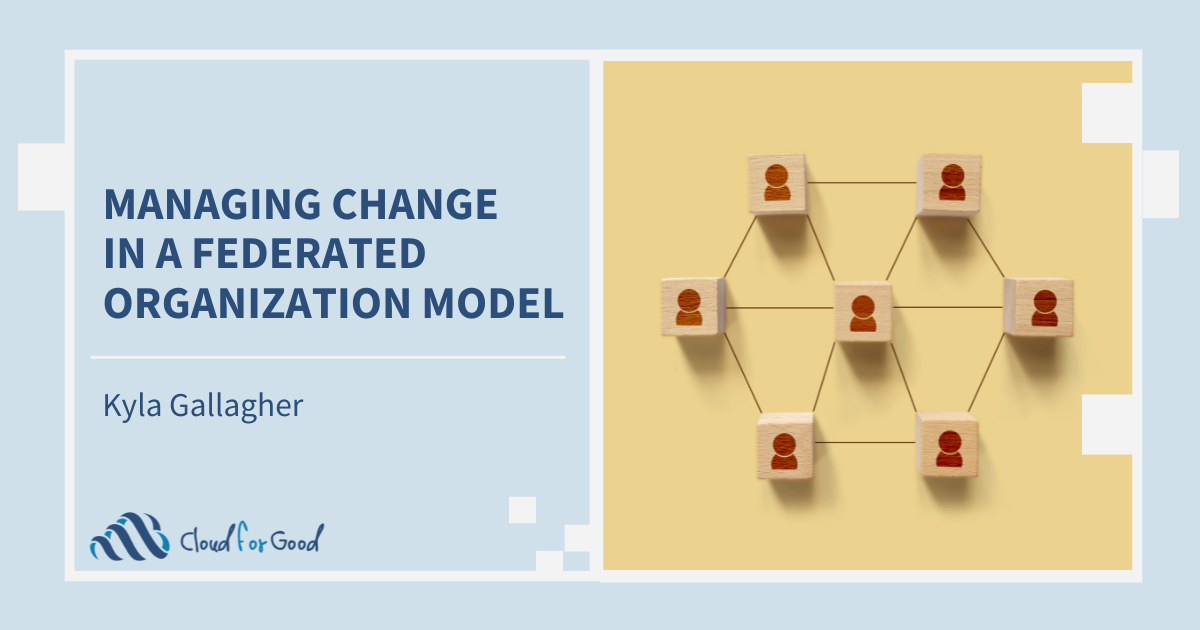In a previous blog, we unpacked the crucial role and value of change management in enabling long-term success in adopting and using new technologies, as well as some common objections to change management. This time, we focus on change management for federated organizations and the unique challenges they face in embracing change.
What is a Federated Organization?
Federated organizations are comprised of a network of individual, affiliated units or entities united under a central governing body or headquarters. Organizations like the United Nations or the University of California system follow this federated operating model. The headquarters of a federated organization maintains a connection to each unit in the network, but the extent of their interactions can vary drastically from organization to organization. For some, units operate completely independently and only share branding or financials with the central office, while others are tightly aligned on all business processes, tools, and staffing. Given that individual units operate with some degree of independence, differences in operational practices and values within the individual unit of a federated organization may lead to the development of distinct organizational cultures from one another.
Change Challenges in Federated Organizations
There are some notable distinctions and implications around the nuances for embracing new systems in federated contexts that go beyond project complexity and basic resistance. A few of the key challenges that Cloud for Good has encountered in working with federated organizations are:
Competing Priorities
Units within a federated organization may have competing priorities or interests, making it difficult to align on common goals. This can lead to internal conflicts and delays in implementation. While a shared vision is at the heart of federated organizations, the existence of autonomy and independence through differing cultures and values across individual units can lead to a perceived lack of alignment on what is most important.
Slower Decision-Making
In federated organizations, decision-making authority and operational control are commonly distributed across individual units. This can result in complex decision-making processes that involve multiple layers of approval in order to move forward. As a result, this can draw out project timelines, leading to stakeholder fatigue and distrust in the process. These delays can also result in higher costs and larger demands on staff resources, making supporting and championing change difficult for staff.
Centralization vs Decentralization
Striking the right balance between central control and local autonomy is an ongoing challenge within federated organizations, and introducing new processes or tools only magnifies the need and importance of finding that right balance. The challenge of finding that balance also demonstrates why embracing change management can be difficult for federated organizations.
Mitigating Risk for Federated Organizations
Alignment, decision-making, and autonomy are part of a federated organization’s foundation, so the success of championing change and adopting and using new technologies depends on prioritizing and embracing change management. From our experience and success completing over 3000 Salesforce implementations for organizations – many of which are federated – we have seen the following practices achieve the most successful results:
Develop a Comprehensive Governance Model
A comprehensive governance body to oversee policies, standards, and decision-making is one of the most crucial aspects of your technology transformation journey. This structure can be leveraged during implementation and for long-term management to ensure the system meets business needs and is ready to evolve alongside the organization. Inviting stakeholders from individual units to participate in this governance body who can represent and advocate for their unit’s local needs and priorities creates a sense of ownership distributed across groups, but all aligned towards the same central goals. Governance strategies developed during the implementation process form the basis for ongoing guidance as the system evolves into the future.
Communication, Honesty, Transparency
Central governing bodies or headquarters should have open, direct, two-way conversations with all affected individual units and their stakeholders to discuss needs, pain points, and major wins while actively listening to and extending their support. Tailored communications with targeted messaging – delivered at the right times and frequencies – for affected groups and clear feedback loops to respond to stakeholders will support staff in feeling heard throughout the process. Once stakeholder motivations are understood, communicate a clear plan for how they will be supported, how long the project will take to implement, a high-level project plan, success metrics, and how the system will support their specific needs. This will help build the trust and alignment pivotal to avoiding costly disagreements, reducing friction, and facilitating implementation success.
Any technology transformation requires hard decisions to be made, which means that not everyone will be completely satisfied all the time. Ensuring stakeholders understand the reasoning behind key decisions and the impact it will have on them will support stakeholders understanding of the overall system and why it was designed the way it was. At a minimum, targeted communications should be developed for each major project milestone. Ideally, communications plans will also cover more audience-specific messaging whenever a decision is made that will impact their individual needs.
Find your Change Champions
While your organization’s leadership may understand the benefits and see the value the new system will bring, not every team or individual in the organization has the same level of visibility. Developing a network of change champions, who are staff representatives from each key user group the system will impact, can build trust and buy-in from within each team. Change champions should be excited about the system, more deeply involved in decision-making during the system design, and empowered with targeted, value-based messaging for their team to stoke interest and inspire adoption. Change champions may also be enabled as super users of the system who are available to support their colleagues as they begin to adopt the system after go-live.
Start Training Early, and Plan for Post-Implementation Support
Ensuring your users are comfortable in a new system is an integral part of making the change process more comfortable for everyone. Create and deliver user-specific, detailed training materials and plans iteratively based on user feedback as the system is developed to empower staff to own their new technology, maximize their usage of it, and ensure user adoption and success in the long term. These training plans and materials should include several different types of training to support users with different learning styles such as hands-on walkthrough videos, training sessions, and 1 on 1 coaching.
In federated organizations, the varied pace for testing, learning, and support requests can be difficult to manage. Planning for a successful go-live experience from the beginning can offset risks later in the project. Defining how you will measure user adoption and success metrics, gather user feedback continually, and use that feedback to inform your decisions and refine your solution during the initial implementation and into the future will give your project a clear vision for success. Coud for Good can support your vision through all phases of the project lifecycle, including long-term post-implementation support for help managing, growing, and optimizing your Salesforce environment through our Managed Services team, and the opportunity to hire trained Salesforce administration staff through our Talent for Good program.
Investing in change from the outset is one of the most crucial contributors to project success, and when working in federated contexts, it comes with a unique suite of challenges. Cloud for Good recognizes that change management takes time, expertise, and attention to work well. Our deep expertise in change management, user adoption, and technology transformations can support your team in navigating the difficult decision-making and changes your staff may encounter on this journey. If you are a federated organization and would like guidance and support on championing change and change management best practices for your technology transformation, contact Cloud for Good today.





